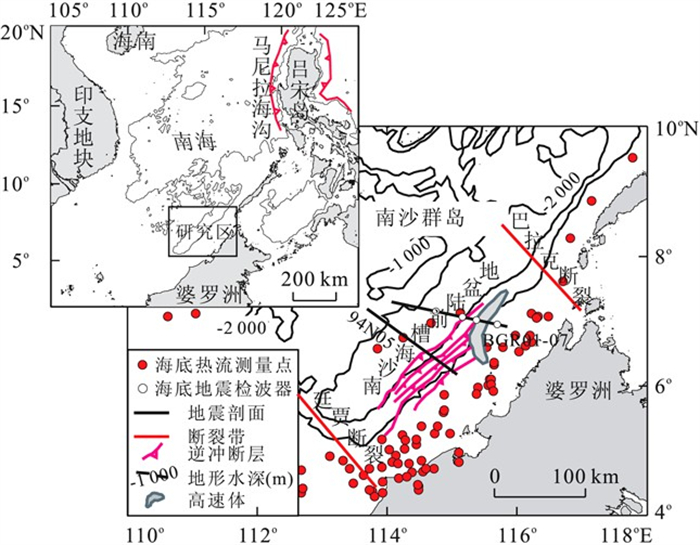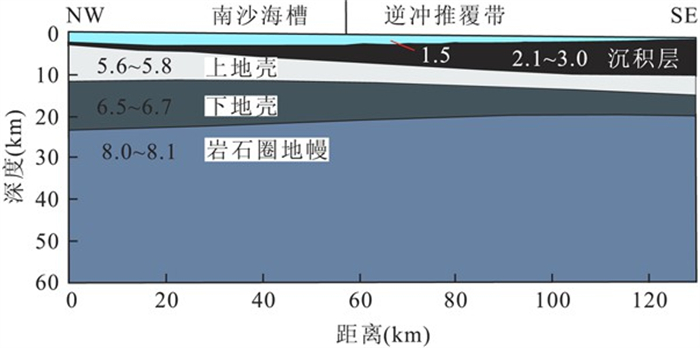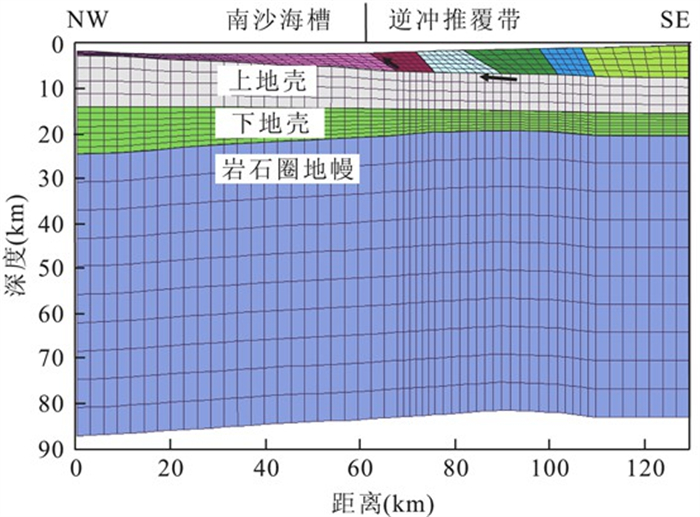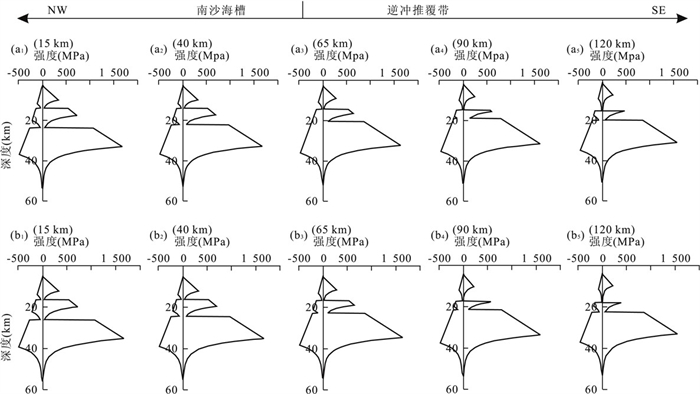Lithospheric Thermal-Rheological Structure of Nansha Trough Foreland Basin in South China Sea
-
摘要: 为了研究南沙海槽前陆盆地深部岩石圈的热力学性质, 在前人所做的地质与地球物理研究工作的基础上, 结合各种岩石热力学流变参数, 采用有限元分析方法, 计算了现今构造逆冲之后和中中新世—全新世逆冲过程活跃时两种状态下的深部岩石圈二维温度场和流变结构.模拟计算表明, 南沙海槽前陆盆地地幔热流贡献达60%~70%, 大地热流受深部地幔控制.逆冲推覆构造作用使盆地逆冲推覆带地表热流显著升高了15%~25%, 达到70~75mW/m2.盆地沉积层温度在200℃以内, 莫霍面温度420~500℃, 地壳地温梯度25~30℃/km, 盆地热岩石圈厚度为80km左右, 横向上变化幅度不大.南沙海槽前陆盆地深部岩石圈流变性质具有明显的分层特性, 为典型的“三明治”结构.盆地岩石圈综合强度由南沙海槽向逆冲推覆带方向呈下降趋势, 盆地力学岩石圈厚度50km左右, 有效弹性厚度为30~32km.通过模拟盆地深部岩石圈热流变结构, 揭示了盆地深部岩石圈具有强地幔、弱地壳的流变学特征, 表现为高强度块体.同时南沙海域地震活动与深部岩石圈热结构、热活动和岩石圈综合强度密切相关.地壳内热构造活动弱、岩石圈强度大可能是区域地震很少发生的重要原因.Abstract: In order to study the lithospheric thermodynamic properties of Nansha trough foreland basin, we simulate the deep lithosphere temperature field and rheological structure during the thrust faults tectonic activities from Middle Miocene to Holocene and after thrusting (static) in the basin using the finite element method, based on previous studies of geological and geophysical data together with a variety of rock thermodynamic parameters.Simulation results indicate that heat flow contribution from mantle reaches 60%-70% of surface heat flow which is controlled by deep mantle in Nansha trough foreland basin.Thrusting movements increase the surface heat flow in thrust-slip fault belts by 15%-25% to 70-75 mW/m2.Our results also show that the temperature of sedimentary layer is less than 200 ℃, while the temperature at Moho varies from 420 to 500 ℃; crust geothermal gradient ranges from 25 to 30 ℃/km.And calculated thickness of thermal lithosphere is about 80 km, which varies slightly laterally.The lithosphere in Nansha waters shows obvious rheological stratification properties, as a typical "sandwich" structure.Horizontally, lithosphere strength decreases in the direction from Nansha trough to thrust belt (NW to SE).The thickness of mechanical lithosphere is about 50 km and the effective elastic thickness ranges from 30 to 32 km.The simulated thermal lithosphere rheological structure also reveals that lithosphere of Nansha basin has rheological characteristics of strong mantle and weak crust, acting as high-strength block.Earthquake activities of Nansha waters are closely related to thermal structure, thermal activity and integrated strength of lithosphere.The weak thermal activity in the crust and high lithosphere strength may be important reasons for rare earthquake occurrence in this area.
-
图 1 南沙海槽前陆盆地地理位置、区域构造及热流测点分布(构造和BGR01-07测线根据Franke et al., 2008; Hesse et al., 2010修改)
Fig. 1. Sketch map of tectonic and topographic map of Nansha trough foreland basin in South China Sea
图 2 南沙海槽前陆盆地94N05测线的剖面地壳结构
图中数字为岩石圈各层地震P波速度, 单位为km/s, 波速据苏达权等(1996)和Franke et al. (2008)修改
Fig. 2. Crust structure of line 94N05 profile of Nansha trough foreland basin
图 3 94N05测线的剖面网格化(剖面位置见图 1)
Fig. 3. Map of grid of line 94N05 profile
表 1 热导率相关参数K0和C值
Table 1. Parameter values K0 and C associated with the thermal conductivity
层位 K0 (W·m-1K-1) C (K-1) 沉积层 2.0 0 UTK层 3.0 1.5×10-3 下地壳 3.0 1.5×10-3 岩石圈上地幔 2.5 -4.0×10-3 注: UTK层、下地壳、岩石圈上地幔的K0按文献 Liu et al. (2005) .表 2 岩石圈各层流变参数(据Fernàndez and Ranalli, 1997)
Table 2. Flow law parameters of lithosphere
层位 材料 A (MPa-n·s-1) n Q (kJ·mol-1) 上地壳(沉积层) 石英岩 1×10-6 2.8 150 下地壳 石英闪长岩 3.2×10-3 3.2 270 岩石圈上地幔 橄榄岩 3.2×104 3.5 535 -
[1] An, M. J., Shi, Y. L., 2007. Three-dimensional temperature field of Chinese continental crust and upper mantle. Science in China (Ser. D), 37(6): 736-745 (in Chinese). [2] Burov, E. B., 2010. The equivalent elastic thickness(Te), seismicity and the long-term rheology of continental lithosphere: time to burn-out"crème brûlée"? Tectonophysics, 484(1-4): 4-26. doi: 10.1016/j.tecto.2009.06.013. [3] Burov, E. B., Diament, M., 1992. Flexure of the continental lithosphere with multilayered rheology. Geophysical Journal International, 109(2): 449-468. doi: 10.1111/j.1365-246X.1992.tb00107.x. [4] Burov, E. B., Diament, M., 1995. The effective elastic thickness(Te)of continental lithosphere: what does it really mean? Journal of Geophysical Research, 100(B3): 3905-3927. doi: 10.1029/94JB02770. [5] Cloetingh, S., Burov, E. B., 1996. Thermomechanical structure of European continental lithosphere: constraints from rheological profiles and EET estimates. Geophysical Journal International, 124(3): 695-723. doi: 10.1111/j.1365-246X.1996.tb05633.x. [6] Fernàndez, M., Ranalli, G., 1997. The role of rheology in extensional basin formation modelling. Tectonophysics, 282(1-4): 129-145. doi: 10.1016/S0040-1951(97)00216-3. [7] Franke, D., Barckhausen, U., Heyde, I., et al., 2008. Seismic images of a collision zone offshore NW Sabah/Borneo. Marine and Petroleum Geology, 25(7): 606-624. doi: 10.1016/j.marpetgeo.2007.11.004. [8] Fu, Y. T., Li, J. L., Zhou, H., et al., 2000. Comments on the effective elastic thickness of continental lithosphere. Geological Review, 46(2): 149-159 (in Chinese with English abstract). http://gji.oxfordjournals.org/cgi/ijlink?linkType=ABST&journalCode=geology&resid=28/6/495 [9] Hall, R., 2002. Cenozoic geological and plate tectonic evolution of SE Asia and the SW Pacific: computer-based reconstructions, model and animations. Journal of AsianEarth Sciences, 20(4): 353-431. doi: 10.1016/S1367-9120(01)00069-4. [10] Hesse, S., Back, S., Franke, D., 2010. The structural evolution of folds in a deepwater fold and thrust belt: a case studyfrom the Sabah continental margin offshore NW Borneo, SE Asia. Marine and Petroleum Geology, 27(2): 442-454. doi: 10.1016/j.marpetgeo.2009.09.004. [11] Hutchison, C. S., 2004. Marginal basin evolution: the southern South China Sea. Marine and Petroleum Geology, 21(9): 1129-1148. doi: 10.1016/j.marpetgeo.2004.07.002. [12] Hutchison, C. S., 2010. The North-West Borneo trough. Marine Geology, 271(1-2): 32-43. doi: 10.1016/j.margeo.2010.01.007. [13] Lin, A., Watts, A. B., 2002. Origin of the West Taiwan basin by orogenic loading and flexure of a rifted continental margin. J. Geophys. Res., 107(B9): 2185, doi: 10.1029/2001JB000669. [14] Liu, S. W., Wang, L. S., Gong, Y. L., et al., 2005. Thermalrheological structure of the lithosphere beneath Jiyang depression: its implications for geodynamics. Science in China (Ser. D), 48(10): 1569-1584. doi: 10.1360/02yd0286. [15] Liu, S. W., Wang, L. S., Jia, C. Z., et al., 2008. Thermalrheological structure of continental lithosphere beneath major basins in central-western China: implications for foreland basin formation. Earth Science Frontiers, 15(3): 113-122 (in Chinese with English abstract). http://en.cnki.com.cn/Article_en/CJFDTOTAL-DXQY200803009.htm [16] Maggi, A., Jackson, J. A., McKenzie, D., et al., 2000. Earth quake focal depths, effective elastic thickness, and the strength of the continental lithosphere. Geology, 28(6): 495-498. doi:10.1130/0091-7613(2000)28<495:EFDEET>2.0.CO;2. [17] McNutt, M., 1990. Flexure reveals great depth. Nature, 343: 596-597. doi: 10.1038/343596a0. [18] Morley, C., 2002. A tectonic model for the tertiary evolution of strike-slip faults and rift basins in SE Asia. Tectonophysics, 347(4): 189-215. doi: 10.1016/S0040-1951(02)00061-6. [19] Morley, C. K., 2009. Growth of folds in a deep-water setting. Geosphere, 5(2): 59-89. doi: 10.1130/GES00186.1. [20] Ou, X. G., Jin, Z. M., Xia, B., et al., 2006. Prediction of thermal conductivity of underground rocks from P-wavevelocity of ultrahigh-pressure metamorphic rocks. Earth Science—Journal of China University of Geosciences, 31(4): 564-568 (in Chinese with English abstract). http://www.researchgate.net/publication/288632071_Prediction_of_thermal_conductivity_of_underground_rocks_from_P-wave_velocity_of_ultrahigh-pressure_metamorphic_rocks [21] Ranalli, G., Murphy, D. C., 1987. Rheological stratificationof the lithosphere. Tectonophysics, 132(4): 281-295. doi: 10.1016/0040-1951(87)90348-9. [22] Shi, X. B., Qiu, X. L., Xia, K. Y., et al., 2003. Characteristics of surface heat flow in the South China Sea. Journal of Asian Earth Sciences, 22(3): 265-277. doi: 10.1016/S1367-9120(03)00059-2. [23] Shi, X. B., Zhou, D., Qiu, X. L., et al., 2002. Thermal andrheological structures of the Xisha trough, South China Sea. Tectonophysics, 351(4): 285-300. doi: 10.1016/S0040-1951(02)00162-2. [24] Shi, X. B., Zhou, D., Zhang, Y. X., 2000. Lithospheric thermal-rheological structures of the continental margin in the northern South China Sea. Chinese Science Bulletin, 45(22): 2107-2112. doi: 10.1007/BF03183537. [25] Simons, W. J. F., Socquet, A., Vigny, C., et al., 2007. A decade of GPS in Southeast Asia: resolving Sundaland motion and boundaries. Journal of Geophysical Research, 112: B06420, doi: 10.1029/2005JB003868. [26] Su, D. Q., Huang, C. L., Xia, K. Y., 1996. The crust in the NanSha trough. Scientic Geologica Sinica, 31(4): 410-415 (in Chinese with English abstract). http://en.cnki.com.cn/article_en/cjfdtotal-dzkx199604009.htm [27] Toussaint, G., Burov, E., Avouac, J. P., 2004. Tectonic evolution of a continental collision zone: a thermomechanical numerical model. Tectonics, 23(6): TC6003. doi: 10.1029/2003TC001604. [28] Wang, L. S., Li, C., Yang, C., 1996. The lithospheric thermal structure beneath Tarim basin, western China. Acta Geophysica Sinica, 39(6): 794-803 (in Chinese with English abstract). [29] Watts, A. B., Burov, E. B., 2003. Lithospheric strength and its relationship to the elastic and seismogenic layer thickness. Earth and Planetary Science Letters, 213(1-2): 113131. doi: 10.1016/S0012-821X(03)00289-9. [30] Watts, A. B., 1992. The effective elastic thickness of the lithosphere and the evolution of foreland basins. Basin Research, 4(3-4): 169-178. doi: 10.1111/j.13652117.1992.tb00043.x. [31] Williams, J., Ruiz, J., Rosenburg, M. A., et al., 2011. Insolation driven variations of mercury's lithospheric strength. Journal of Geophysical Research, 116: E01008. doi: 10.1029/2010JE003655. [32] Wu, S. M., Zhou, D., Liu, H. L., 2004. Tectonic framework and evolutionary charateristics of Nansha block, South China Sea. Geotectonica et Metallogenia, 28(1): 23-28 (in Chinese with English abstract). http://epub.cnki.net/grid2008/docdown/docdownload.aspx?filename=DGYK200401003&dbcode=CJFD&year=2004&dflag=pdfdown [33] Wu, Y., Jin, Z. M., Ou, X. G., et al., 2005. Lithosphereic thermal structure beneath the area of the Chinese continental scientific drilling site (CCSD). Acta Petrologica Sinica, 21(2): 439-450 (in Chinese with English abstract). http://www.researchgate.net/profile/Yao_Wu11/publication/287195678_Lithospheric_thermal_structure_beneath_the_area_of_the_Chinese_Continental_Scientific_Drilling_Site_CCSD/links/5672291d08ae54b5e45fbbe7.pdf [34] Zang, S. X., Li, C., Ning, J. Y., et al., 2003. A preliminary model for 3-D rheological structure of the lithosphere in North China. Science in China (Ser. D), 46(5): 461473. doi: 10.1360/03yd9040. [35] Zhang, J., Song, H. B., 2001. The thermal structure of main sedimentary basins in the northern margin of the South China Sea. Journal of Geomechanics, 7(3): 238-244 (in Chinese with English abstract). http://www.researchgate.net/publication/283689077_The_thermal_structure_of_main_sedimentary_basins_in_the_northern_margin_of_the_South_China_Sea [36] Zhao, L. H., Jiang, X. D., Jin, Y., et al., 2004. Effective elastic thickness of continental lithosphere in western China. Earth Science—Journal of China University ofGeosciences, 29(2): 183-190 (in Chinese with English abstract). http://en.cnki.com.cn/Article_en/CJFDTOTAL-DQKX200402010.htm [37] Zhou, D., Yao, B. C., 2009. Tectonics and sedimentary basins of the South China Sea: challenges and progresses. Journal of Earth Science, 20(1): 1-12. doi: 10.1007/s12583-009-0001-8. [38] Zhou, D., Yu, H. S., Xu, H. H., et al., 2003. Modeling of thermo-rheological structure of lithosphere under the foreland basin and mountain belt of Taiwan. Tectonophysics, 374(3-4): 115-134. doi: 10.1016/S00401951(03)00236-1. [39] 安美建, 石耀霖, 2007. 中国大陆地壳和上地幔三维温度场. 中国科学(D辑), 37(6): 736-745. https://www.cnki.com.cn/Article/CJFDTOTAL-JDXK200706003.htm [40] 付永涛, 李继亮, 周辉, 等, 2000. 大陆岩石圈有效弹性厚度研究综述. 地质论评, 46(2): 149-159. doi: 10.3321/j.issn:0371-5736.2000.02.005 [41] 刘绍文, 王良书, 贾承造, 等, 2008. 中国中西部盆地区岩石圈热—流变学结构及其对前陆盆地成因演化的意义. 地学前缘, 15(3): 113-122. doi: 10.3321/j.issn:1005-2321.2008.03.008 [42] 欧新功, 金振民, 夏斌, 等, 2006. 利用超高压变质岩的P波速度估算地下岩石的热导率. 地球科学——中国地质大学学报, 31(4): 564-568. https://www.cnki.com.cn/Article/CJFDTOTAL-DQKX200604014.htm [43] 苏达权, 黄慈流, 夏戡原, 1996. 论南沙海槽的地壳性质. 地质科学, 31(4): 409-415. https://www.cnki.com.cn/Article/CJFDTOTAL-DZKX199604009.htm [44] 王良书, 李成, 杨春, 1996. 塔里木盆地岩石层热结构特征. 地球物理学报, 39(6): 794-803. doi: 10.3321/j.issn:0001-5733.1996.06.009 [45] 吴世敏, 周蒂, 刘海龄, 2004. 南沙地块构造格局及其演化特征. 大地构造与成矿学, 28(1): 23-28. doi: 10.3969/j.issn.1001-1552.2004.01.004 [46] 吴耀, 金振民, 欧新功, 等, 2005. 中国大陆科学钻探(CCSD)主孔地区岩石圈热结构. 岩石学报, 21(2): 439-450. https://www.cnki.com.cn/Article/CJFDTOTAL-YSXB200502019.htm [47] 张健, 宋海斌, 2001. 南海北部大陆架盆地热结构. 地质力学学报, 7(3): 238-244. doi: 10.3969/j.issn.1006-6616.2001.03.007 [48] 赵俐红, 姜效典, 金煜, 等, 2004. 中国西部大陆岩石圈的有效弹性厚度研究. 地球科学——中国地质大学学报, 29(2): 183-190. https://www.cnki.com.cn/Article/CJFDTOTAL-DQKX200402010.htm -










 下载:
下载:





